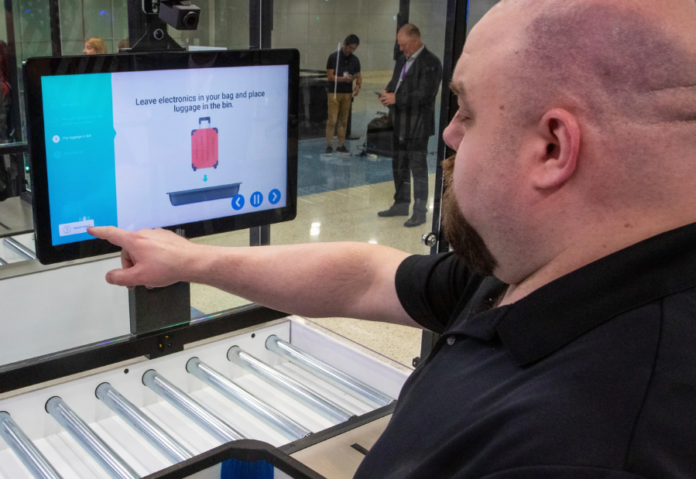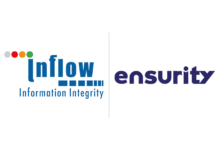Federal airport security authorities have unveiled a passenger self-screening checkpoint at Harry Reid International Airport in Las Vegas, which they hope to test this year before implementing it across the country.
Federal airport security authorities debuted passenger self-screening lanes Wednesday at Las Vegas’ popular Harry Reid International Airport, with plans to test them in other locations throughout the country.
“How do we move into the future? This is a start,” said Dimitri Kusnezov, an undersecretary of science and technology at the United States Department of Homeland Security. “The interface with people makes all the difference.”
The Transportation Security Administration checkpoint, which was initially only in Las Vegas, only for TSA PreCheck customers, and only in English, features a screen with self-help instructions on how to pass themselves and their carry-on luggage through pre-flight screening with little or no assistance from uniformed TSA officers.
“We want to avoid passengers having to be patted down,” said John Fortune, program manager of the Department of Homeland Security’s “Screening at Speed” program and prototype creator alongside Kusnezov.
Rather than a boxy belt-fed apparatus with a stack of gray trays, the futuristic-looking baggage and personal items inspection system resembles a scaled-down starship medical magnetic resonance imaging scanner. It has an automated bin return that sanitizes trays with germ-killing UV light in between users.
Travelers enter a separate clear glass body scanning booth with a television display inside that shows how to stand when “millimeter wave technology” is detected, according to officials. A reporter deemed it critical enough to identify a forgotten handkerchief.
“Really, one of the main aims here is to allow individuals to get through the system without necessarily having to interact directly with an officer and… at their own pace,” said Christina Peach, a TSA administrator involved in the system design. “It’s also about not feeling rushed.”
Nationally, nearly all passengers who pay to enroll in the TSA PreCheck program pass through screening in 10 minutes or less, according to agency spokesman R. Carter Langston, whereas ordinary traveler and carry-on screening takes around 30 minutes.
Peach stated that eight uniformed TSA agents may be required to staff two lanes of the new system, compared to 12 officers in lanes currently.
Kusnezov and Karen Burke, TSA federal security director in Nevada, said agents, including union members, would simply be relieved of hands-on screening so that they could focus more on broader security concerns.
“No one is going to lose their job,” Burke stated.
Fortune declined to estimate the cost of designing the system, but he did say the scanners used were similar to those already in place across the country.
Officials said they will measure how quickly travelers pass through the prototype during this year’s evaluations.
Testing is taking place at a one-of-a-kind “innovation checkpoint” that the TSA presented in 2019 at the enormous international arrivals terminal at Harry Reid Airport, which opened in 2012. It already has screening lanes, instruction displays, and anticipated wait times.
“This technology change is for people who want to get through a checkpoint faster,” said Keith Jeffries, a former TSA director at Los Angeles International Airport and now vice president of K2 Security Screening Group, a company that installs screening systems at shipping ports, including airports. “It’ll be a great step, but I anticipate it will be for experienced passengers.”
According to a source on Tuesday, Jeffries compared the new method to self-checkout lanes, which were introduced in the 1980s and are now widely available at supermarkets around the country. He recalls how some customers initially avoided scanning their own items.
“It will take time to educate the public,” he added about the TSA screening lanes. “A new generation of passengers will want to get through with as little fuss and delay as possible. I believe we will witness an increase in their numbers in the future.”
Harry Reid International Airport was the eighth busiest passenger airport in the United States in 2022, according to Airports Council International, trailing only New York’s John F. Kennedy International Airport. In 2023, the Las Vegas airport handled a new high of 57.6 million arriving and leaving passengers.
The Transportation Security Administration announced its busiest day ever at the airport last month, inspecting over 104,000 travelers and their luggage as they prepared for airline flights on February 12, the day following.
Also read: The Road Ahead: Predictions for the Future Evolution of Artificial Intelligence
Do Follow: CIO News LinkedIn Account | CIO News Facebook | CIO News Youtube | CIO News Twitter
About us:
CIO News, a proprietary of Mercadeo, produces award-winning content and resources for IT leaders across any industry through print articles and recorded video interviews on topics in the technology sector such as Digital Transformation, Artificial Intelligence (AI), Machine Learning (ML), Cloud, Robotics, Cyber-security, Data, Analytics, SOC, SASE, among other technology topics.






